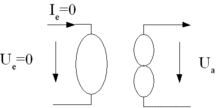Nullor
As a nullor is known in the theory of electrical networks , a two-port network that consists of a nullator at the entrance and a norator composed at the output. The name was coined by HJ Carlin in 1965.
For the classic description as a two-port only the chain matrix A exists , whose parameters are all zero, which is why the nullor has no defined input or output impedance:
The concept of a nullor only makes sense in connection with an external negative feedback network, through which the resulting currents and voltages are defined. The output voltage U a or the output current I a is then determined by the nullor in such a way that the input voltage U e and the input current I e become 0 through the external feedback network.
The nullor is a theoretical model that can be used to describe an ideal operational amplifier in the linear range. To do this, one of the two Norator connections is placed on a reference point (ground) that is neglected in the operational amplifier symbol. The other three connections then model the ideal operational amplifier, the behavior of which is also determined by an external negative feedback. This idealized operational amplifier, like the nullor itself, has no defined input and output impedances and can therefore be used as a model for all different variants of an operational amplifier.
literature
- Lecture Circuit Technology 1. (PDF; 2.0 MB) Prof. Dr. techn. Josef A. Nossek, October 9, 2012, accessed on July 11, 2017 .
Individual evidence
- ^ HJ Carlin: Singular network elements , IEEE Trans. Circuit Theory, March 1965, Issue CT-11, pages 67-72.
- ↑ Raj Senani, AK Singh, Pragati Kumar, and RK Sharma: Nullors, Their Bipolar and CMOS Implementations and Applications in Analog Circuit Synthesis and Design . In: Integrated Circuits for Analog Signal Processing, Springer 2012 .

